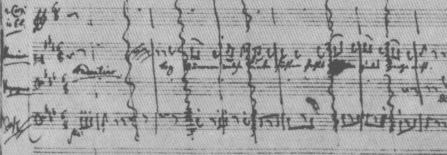| Mozart´s Tempo-System |  |
| home | deutsch | english | français | italiano | music & diagrams | metronome | literature | impressum |
|
Helmut Breidenstein "Mozart's Tempo Indications. What do they refer to?" FOOTNOTES: (a klick with the right key of your mouse on "back" brings you to the main text.) (1) Claudia Maurer Zenck, "Vom Takt" (Wien: Böhlau-Verlag, 2001), 70. (2) Which incidentally means that for him Andante was not a slow tempo! (3) Maurer Zenck, 87. (4) Rondo of his Flute Quartet in A major, K. 298. (5) He only used 3/2 and 4/2 – and characteristically without a tempo indication – in several movements in the stilo antico: in K. 49, 85 and 321, and never 6/4; these meters were by that time already considered as old-fashioned. (6) In some 190 cases even foreword and critical notes give no information on the source. (7) If René Leibowitz insists that Mozart’s Andante ¢ should be conducted in half notes, to be consistent he would then also have to conduct the Presto-3/8 sections in eighth notes, which of course he does not. ("Tempo und dramatischer Sinn in Mozart’s ‚Don Giovanni", in: "Mozart. Die Da Ponte-Opern", "Musik-Konzepte", Sonderband, ed. text + kritik, München, 1991, 212fn) (8) 508 out of 725 movements by Mozart in 4/4 time belong to this category. (9) Jean-Jacques Rousseau: "The Paris Opera is the only theatre in Europe where time is beaten without being observed; in all other places time is observed without being beaten" ("Dictionnaire de Musique", vol. 1, article "Battre la Mesure", 114 ) (10) Hans Swarowsky / Manfred Huss, "Wahrung der Gestalt", Wien, 1979, p 76: "The establishment of the modern way of conducting has robbed much of the feeling for a naturally appropriate tempo". And also very nice: "Music which has never asked to be conducted is the most difficult music to conduct." (11) There is also the modern term "added" meter, which to my mind does not make it clear enough that measures as entities are meant. (12) With regard to 6/8 meter this should read four "weak" beats; Koch had taken the wording uncorrected from the entry on 4/4 meter. (Heinrich Christoph Koch "Musikalisches Lexikon", Frankfurt, 1802, reprint: Hildesheim, Georg Olms, 1964, c. 1307 and 1482. (13) Johann Philipp Kirnberger (in collaboration with Johann Abraham Peter Schulz): "Die Kunst des reinen Satzes in der Musik" ("The Art of pure Writing in Music") 2nd part, Berlin and Königsberg 1776, 116. - A work on which Triest comments in the Leipzig periodical "Allgemeine Musikalische Zeitung" in 1801 that "particularly due to its consistency and clarity surpasses all similar publications and will perhaps continue to do so for a substantial period of time and the study of which no serious young composer can go without." ("Bemerkungen über die Ausbildung der Tonkunst in Deutschland im achtzehnten Jahrhundert") ["Remarks on the cultivation of the art of music in Germany in the eighteenth century"]. (14)
See
Mozart’s shifting of the bar-lines by half a measure in the
Duet
Pamina-Papageno "Bei Männern, welche Liebe fühlen"
(Zauberflöte, No. 7) , and in the Quartet
"La mano a
me date" (Cosi fan tutte, No. 22) which would not
have
been possible in simple 6/8 meter. (15) Friedrich Wilhelm Marpurg: "Kritische Briefe über die Tonkunst" ("Critical Letters about the Musical Art"), vol. II, Berlin 1762, 25. (16) Kirnberger, 131. (17) Heinrich Christoph Koch: "Versuch einer Anleitung zur Composition", Leipzig, 1787, Reprint Hildesheim, 1964, 2nd part, 333, 335. (18) in: Manfred Hermann Schmid (ed.), "Mozart-Studien" 13, Tutzing, 2004, 11-85. (19) Marpurg, vol. I, 100, § 6. (20) Kirnberger, 133. (21) Leopold Mozart, "Versuch einer gründlichen Violinschule" ("Attempt at a Comprehensive Violin Method"), Augsburg, 1756, 28. (22) Kirnberger, 106 (23) "It is above all Johannes Antonius Bank (1972) and Uwe Wolf (1992) who speak out against the assumption of tempo proportions [in the 18th century]. Among other things they refer to the numerous new time signatures – nonsensical as proportions –, to corresponding statements in certain treatises [...] and forewords as well as the complete absence of any references to a proportional interpretation e.g. of the verbal tempo indications." ("Musik in Geschichte und Gegenwart" II, Sachteil, vol. 7, 1997, article "Notation") and also Klaus Miehling ("Das Tempo in der Musik von Barock und Vorklassik", Wilhelmshaven, 1993, 334) (24) Johann Abraham Peter Schulz in J.G. Sulzer’s "Allgemeine Theorie der Schönen Künste", Volume IV, Leipzig 1794, reprint: Hildesheim, Georg Olms, 1967, p 497. (25) "Vortrag": the art of a performer using his mechanical skill of execution with consideration of the character and purpose of the composition. Tempo, dynamics, articulation, agogics and embellishments are the essential components of a good "Vortrag"." [This is the gist of what F.W. Marpurg says about "Vortrag" in his "Critical Letters about the Art of Music" (1760) vol. I, p 500]. - H.Chr. Koch describes the task of a good ‚Vortrag‘ as "representation of the actual meaning and the spirit of a piece of music" (in his "Musikalisches Lexikon", column 1.729). (26) J.A.P. Schulz in Sulzer, volume IV, 701-709. (27) Kirnberger, 105 (28) Joh. Friedrich Reichardt (1752-1814), Royal Prussian court music director: "Über die Pflichten des Ripien-Violinisten", Berlin and Leipzig, 1776, 25-27, 69. (29) J.A.P. Schulz in Sulzer, vol. IV, 493/94 (30) Swarowsky, 67. (31) And I dare to consider that Beethoven’s – and our own – difficulties with his metronomization stem from this. (32) Jean-Pierre Marty ("The Tempo Indications of Mozart", 1988), bases his somewhat subjective metronomization of Mozart’s tempi on an arbitrary scale of walking speeds of either MM=60 or MM=44, which in a classical circular reasoning leads to such statements as all of Mozart’s Andante ¢ were either 1/2=60 or 1/2=44. (33) Particularly by Quantz two generations earlier (!) with his tempo/pulse-rate table intended for pupils ! (34) Leopold Mozart, 30. |